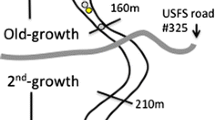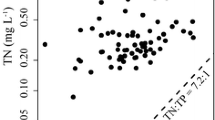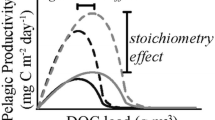Abstract
Light-use efficiency (LUE) describes conversion of incident light into gross primary production (GPP), combining the inherent photosynthetic efficiency of chloroplasts with light-capture ability of the autotrophic community. In lotic ecosystems, LUE is poorly constrained, in part because most studies neglect water-column attenuation. We hypothesized that rigorous quantification of benthic light would (1) improve GPP predictions and (2) constrain cross-site variation in LUE. We used a field-validated light model to successively attenuate open-sky irradiance through the riparian canopy and water column to estimate benthic light at 11 sites spanning discharge and dissolved-color gradients where we simultaneously calculated daily GPP. Our results indicate substantial water-column attenuation (up to 96% of stream-surface light), implying significant underestimation of LUE using stream-surface light alone. Benthic light dramatically improved GPP predictions, especially after considering mean-light conditions, which we suggest enumerates ecosystem light-capture ability due to biomass density. The model including mean-light effects explained 78% of GPP variation across sites and yielded a LUE identical to terrestrial ecosystems (1.9%). Interactions between daily and mean-light only slightly improved model fit (R2 = 0.80), implying higher LUE at sites with higher mean light, but notably reduced LUE variation across sites compared with individual site analyses. This suggests that better representation of benthic light regimes leads to LUE convergence. Our study supports use of a global river LUE to translate large-scale predictions of stream light regimes into expected GPP, from which disturbance and nutrient limitation effects can then be discerned.




Similar content being viewed by others
References
Acuña V, Giorgi A, Muñoz I, Uehlinger U, Sabater S. 2004. Flow extremes and benthic organic matter shape the metabolism of a headwater Mediterranean stream. Freshwater Biology 49:960–71.
Appling AP, Hall RO, Yackulic CB, Arroita M. 2018a. Overcoming equifinality: leveraging long time series for stream metabolism estimation. Journal of Geophysical Research Biogeosciences 123:624–45.
Appling AP, Read JS, Winslow LA, Arroita M, Bernhardt ES, Griffiths NA, Hall RO, Harvey JW, Heffernan JB, Stanley EH, Stets EG, Yackulic CB. 2018b. Data descriptor: the metabolic regimes of 356 rivers in the United States. Sci Data 5:1–14.
Barnes DJ, Lazar B. 1993. Metabolic performance of a shallow reef patch near Eilat on the Red Sea. Journal of Experimental Marine Biology and Ecology 174:1–13.
Beaulieu JJ, Arango CP, Balz DA, Shuster WD. 2013. Continuous monitoring reveals multiple controls on ecosystem metabolism in a suburban stream. Freshwater Biology 58:918–37.
Bernhardt ES, Heffernan JB, Grimm NB, Stanley EH, Harvey JW, Arroita M, Appling AP, Cohen MJ, McDowell WH, Hall RO, Read JS, Roberts BJ, Stets EG, Yackulic CB. 2018. The metabolic regimes of flowing waters. Limnology and Oceanography 63:S99–118.
Binkley D, Stape JL, Ryan MG. 2004. Thinking about efficiency of resource use in forests. Forest Ecology and Management 193:5–16.
Binzer T, Sand-Jensen K. 2002. Importance of structure and density of macroalgae communities (Fucus serratus) for photosynthetic production and light utilisation. Marine Ecology Progress Series 235:53–62.
Bott TL, Brock JT, Dunn CS, Naiman RJ, Ovink RW, Petersen RC. 1985. Benthic community metabolism in four temperate stream systems: an inter-biome comparison and evaluation of the river continuum concept. Hydrobiologia 123:3–45.
Brylinsky M. 1980. Estimating the productivity of lakes and reservoirs. In: Le Cren ED, Lowe-McConnell RH, Eds. The functioning of freshwater ecosystems. New York: Cambridge University Press. p 588.
Chow WS, Melis A, Anderson JM. 1990. Adjustments of photosystem stoichiometry in chloroplasts improve the quantum efficiency of photosynthesis. Proceedings of the National Academy of Sciences 87:7502–6.
Covino TP, Bernhardt ES, Heffernan JB. 2018. Measuring and interpreting relationships between nutrient supply, demand, and limitation. Freshwater Science 37:448–55.
Davies-Colley RJ, Nagels JW. 2008. Predicting light penetration into river waters. Journal of Geophysical Research 113:G03028.
Davies-Colley RJ, Smith DG. 2001. Turbidity, suspended sediment, and water clarity: a review. Journal of the American Water Resources Association 37:1085–101.
Dodds WK, Hutson RE, Eichem AC, Evans MA, Gudder DA, Fritz KM, Gray L. 1996. The relationship of floods, drying, flow and light to primary production and producer biomass in a prairie stream. Hydrobiologia 333:151–9.
Dodds WK, Veach AM, Ruffing CM, Larson DM, Fischer JL, Costigan KH. 2013. Abiotic controls and temporal variability of river metabolism: multiyear analyses of Mississippi and Chattahoochee River data. Freshwater Science 32:1073–87.
Duarte CM, Prairie YT, Frazer TK, Hoyer MV, Notestein SK, Martínez R, Dorsett A, Canfield DE. 2010. Rapid accretion of dissolved organic carbon in the springs of Florida: the most organic-poor natural waters. Biogeosciences 7:4051–7.
Duffer WR, Dowis TC. 1966. Primary productivity in a southern Great Plains stream. Limnology and Oceanography 11:143–51.
Edwards RW, Owens M. 1962. The effects of plants on river conditions IV. The oxygen balance of a chalk stream. Journal of Ecology 50:207–20.
Field CB. 1991. Ecological scaling of carbon gain to stress and resource availability. In: Mooney HA, Winner WE, Pell EJ, editors. Response of plants to multiple stresses. Academic Press. p 422.
Fisher SG, Gray LJ, Grimm NB, Busch DE. 1982. Temporal succession in a desert stream ecosystem following flash flooding. Ecological Monographs 52:93–110.
Flemer DA. 1970. Primary productivity of the North Branch of the Raritan River, New Jersey. Hydrobiologia 35:273–96.
Fork ML, Heffernan JB. 2014. Direct and indirect effects of dissolved organic matter source and concentration on denitrification in Northern Florida Rivers. Ecosystems 17:14–28.
Garbulsky MF, Peñuelas J, Papale D, Ardö J, Goulden ML, Kiely G, Richardson AD, Rotenberg E, Veenendaal EM, Filella I. 2010. Patterns and controls of the variability of radiation use efficiency and primary productivity across terrestrial ecosystems. Global Ecology and Biogeography 19:253–67.
Gitelson AA, Gamon JA. 2015. The need for a common basis for defining light-use efficiency: implications for productivity estimation. Remote Sensing of Environment 156:196–201.
Godwin SC, Jones SE, Weidel BC, Solomon CT. 2014. Dissolved organic carbon concentration controls benthic primary production: results from in situ chambers in north-temperate lakes. Limnology and Oceanography 59:2112–20.
Hall RO, Beaulieu JJ. 2013. Estimating autotrophic respiration in streams using daily metabolism data. Freshwater Science 32:507–16.
Hall RO, Yackulic CB, Kennedy TA, Yard MD, Rosi-Marshall EJ, Voichick N, Behn KE. 2015. Turbidity, light, temperature, and hydropeaking control primary productivity in the Colorado River, Grand Canyon. Limnology and Oceanography 60:512–26.
Haxeltine A, Prentice IC. 1996. A general model for the light-use efficiency of primary production. Functional Ecology 10:551–61.
Heffernan JB, Cohen MJ, Frazer TK, Thomas RG, Rayfield TJ, Gulley J, Martin JB, Delfmo JJ, Graham WD. 2010a. Hydrology and biotic influences on nitrate removal in a subtropical spring-fed river. Limnology and Oceanography 55:249–63.
Heffernan JB, Liebowitz DM, Frazer TK, Evans JM, Cohen MJ, Heffernan JB, Liebowitz DM, Frazer T, Evans JM, Cohen MJ. 2010b. Algal blooms and the nitrogen-enrichment hypothesis in Florida springs: evidence, alternatives, and adaptive management. Ecological Applications 20:816–29.
Hensley RT, Cohen MJ, Korhnak LV. 2015. Hydraulic effects of nitrogen removal in a tidal spring-fed river. Water Resources Research 51:1443–56.
Hensley RT, Kirk L, Spangler M, Gooseff MN, Cohen MJ. 2019. Flow extremes as spatiotemporal control points on river solute fluxes and metabolism. Journal of Geophysical Research Biogeosciences 124:537–55.
Hilker T, Coops NC, Wulder MA, Black TA, Guy RD. 2008. The use of remote sensing in light use efficiency based models of gross primary production: a review of current status and future requirements. Science of the Total Environment 404:411–23.
Hill WR, Dimick SM. 2002. Effects of riparian leaf dynamics on periphyton photosynthesis and light utilisation efficiency. Freshwater Biology 47:1245–56.
Hill WR, Mulholland PJ, Marzolf ER. 2001. Stream ecosystem responses to forest leaf emergence in spring. Ecology 82:2306–19.
Hilton J, O’Hare M, Bowes MJ, Jones JI. 2006. How green is my river? A new paradigm of eutrophication in rivers. Science of the Total Environment 365:66–83.
Hoellein TJ, Bruesewitz DA, Richardson DC. 2013. Revisiting Odum (1956): a synthesis of aquatic ecosystem metabolism. Limnology and Oceanography 58:2089–100.
Hornberger GM, Kelly MG, Eller RM. 1976. The relationship between light and photosynthetic rate in a river community and implications for water quality modeling. Water Resources Research 12:723–30.
Julian JP, Doyle MW, Stanley EH. 2008a. Empirical modeling of light availability in rivers. Journal of Geophysical Research 113:1–16.
Julian JP, Stanley EH, Doyle MW. 2008b. Basin-scale consequences of agricultural land use on benthic light availability and primary production along a sixth-order temperate river. Ecosystems 11:1091–105.
Khadka MB, Martin JB, Jin J. 2014. Transport of dissolved carbon and CO2 degassing from a river system in a mixed silicate and carbonate catchment. Journal of Hydrology 513:391–402.
King SA, Heffernan JB, Cohen MJ. 2014. Nutrient flux, uptake, and autotrophic limitation in streams and rivers. Freshwater Science 33:85–98.
Kirk JTO. 1994. Light and photosynthesis in aquatic ecosystems. Cambridge University Press.
Kolber Z, Wyman KV, Falkowski PG. 1990. Natural variability in photosynthetic energy conversion efficiency: a field study in the Gulf of Maine. Limnology and Oceanography 35:72–9.
Lindeman RL. 1942. The trophic-dynamic aspect of ecology. Ecology 23:399–417.
Mäkelä A, Pulkkinen M, Kolari P, Lagergren F, Berbigier P, Lindroth A, Loustau D, Nikinmaa E, Vesala T, Hari P. 2008. Developing an empirical model of stand GPP with the LUE approach: analysis of eddy covariance data at five contrasting conifer sites in Europe. Global Change Biology 14:92–108.
McBride J, Cohen MJ. 2019. Controls on productivity of submerged aquatic vegetation in 2 spring-fed rivers. Freshwater Science 39.
Mcmurtrie RE, Gholz HL, Linder S, Gower ST. 1994. Climatic factors controlling the productivity of pine stands: a model-based analysis. Ecological Bulletins 173–88.
Medlyn BE. 1998. Physiological basis of the light use efficiency model. Tree Physiology 18:167–76.
Meyer JL. 1990. A blackwater perspective on riverine ecosystems. Bioscience 40:643.
Monteith JL. 1972. Solar radiation and productivity in tropical ecosystems. Journal of Applied Ecology 9:747–66.
Monteith JL, Moss CJ. 1977. Climate and the efficiency of crop production in Britain. Philosophical Transactions of the Royal Society of Biological Sciences 281:277–94.
Mulholland PJ, Fellows CS, Grimm NB, Webster JR, Hamilton SK, Marti E, Ashkenas L, Bowden WB, Dodds WK, Mcdowell WH, Paul MJ, Peterson BJ. 2001. Inter-biome comparision of factors controlling stream metabolism. Freshwater Biology 46:1503–17.
Munch DA, Toth DJ, Huang C, Davis JB, Fortich CM, Osburn WL, Phlips EJ, Allen MS, Knight RL. 2006. Fifty-year retrospecitve study of the ecology of Silver Springs, Florida.
Odum EP. 1975. Ecology: Modern Biology Series.
Odum HT. 1956. Primary production in flowing waters. Limnology and Oceanography 1:102–17.
Odum HT. 1957a. Primary production measurements in eleven florida springs and a marine turtle-grass community. Limnology and Oceanography 2:85–97.
Odum HT. 1957b. Trophic structure and productivity of Silver Springs. Ecological Monographs 27:55–112.
Peterson CG, Stevenson RJ. 1992. Resistance and resilience of lotic algal communities: importance of disturbance timing and current. Ecology 73:1445–61.
Phlips EJ, Cichra M, Aldridge FJ, Jembeck J, Hendrickson J, Brody R. 2000. Light availability and variations in phytoplankton standing crops in a nutrient-rich blackwater river. Limnology and Oceanography 45:916–29.
Raymond PA, Zappa CJ, Butman D, Bott TL, Potter J, Mulholland P, Laursen AE, McDowell WH, Newbold D. 2012. Scaling the gas transfer velocity and hydraulic geometry in streams and small rivers. Limnology and Oceanography Fluids and Environment 2:41–53.
Riley GA. 1944. The carbon metabolism and photosynthetic efficiency of the earth as a whole. American Scientist 32:129–34.
Roberts BJ, Mulholland PJ, Hill WR. 2007. Multiple scales of temporal variability in ecosystem metabolism rates: results from 2 years of continuous monitoring in a forested headwater stream. Ecosystems 10:588–606.
Rosemond AD, Mulholland PJ, Brawley SH. 2000. Seasonally shifting limitation of stream periphyton: response of algal populations and assemblage biomass and productivity to variation in light, nutrients, and herbivores. Canadian Journal of Fisheries and Aquatic Sciences 57:66–75.
Ruimy A, Saugier B. 1994. Methodology for the estimation of terrestrial net primary production from remotely sensed data data. Journal of Geophysical Research 99:5263–83.
Saldarriaga JG, Luxmoore RJ, Calle N, Program T. 1991. Solar energy conversion efficiencies during succession of a tropical rain forest in Amazonia. Journal of Tropical Ecology 7:233–42.
Sand-Jensen K. 1997. Broad-scale comparison of photosynthesis in terrestrial and aquatic plant communities. Oikos 80:203–8.
Sand-Jensen K, Binzer T, Middelboe AL. 2007. Scaling of photosynthetic production of aquatic macrophytes—a review. Oikos 116:280–94.
Savoy P, Bernhardt E, Kirk L, Cohen MJ, Heffernan JB. In review. A seasonally dynamic model of light at the stream surface. Freshwater Science.
Sawall Y, Hochberg EJ. 2018. Diel versus time-integrated (daily) photosynthesis and irradiance relationships of coral reef organisms and communities. PLoS One 13:1–14.
Schwalm CR, Black TA, Amiro BD, Arain MA, Barr AG, Bourque CPA, Dunn AL, Flanagan LB, Giasson MA, Lafleur PM, Margolis HA, McCaughey JH, Orchansky AL, Wofsy SC. 2006. Photosynthetic light use efficiency of three biomes across an east-west continental-scale transect in Canada. Agricultural and Forest Meteorology 140:269–86.
Scott TM, Means GH, Meegan RP, Means RC, Upchurch SB, Copeland RE, Jones J, Roberts T, Willet A. 2004. Springs of Florida.
Singsaas EL, Ort DR, DeLucia EH. 2001. Variation in measured values of photosynthetic quantum yield in ecophysiological studies. Oecologia 128:15–23.
Slattery RA, Ort DR. 2015. Photosynthetic energy conversion efficiency: setting a baseline for gauging future improvements in important food and biofuel crops. Plant Physiology 168:383–92.
Segatto PL, Battin TJ, Bertuzzo E. 2020. Modeling the coupled dynamics of stream metabolism and microbial biomass. Limnology and Oceanography: 1–21.
Thompson CG, Kim RS, Aloe AM, Becker BJ. 2017. Extracting the variance inflation factor and other multicollinearity diagnostics from typical regression results. Basic Applied Sociology and Psychology 39:81–90.
Turner DP, Urbanski S, Bremer D, Wofsy SC, Meyers T, Gower ST, Gregory M. 2003. A cross-biome comparison of daily light use efficiency for gross primary production. Global Change Biology 9:383–95.
Vannote RL, Minshall GW, Cummins KW, Sedell JR, Cushing CE. 1980. The river continuum concept. Canadian Journal of Fisheries and Aquatic Sciences 37:130–7.
Villamizar SR, Pai H, Butler CA, Harmon TC. 2014. Transverse spatiotemporal variability of lowland river properties and effects on metabolic rate estimates. Water Resources Research 50:482–93.
Wagner R, Boulger R, Oblinger C, Smith B. 2006. Guidelines and standard procedures for continuous water-quality monitors: station operation, record computation, and data reporting. U.S. Geological Survey Techniques and Methods 1–D3, 51 p. + 8 attachments.
Wassink EC. 1959. Efficiency of light energy conversion in plant growth. Plant Physiology.
Wofsy SC, Goulden ML, Munger JW, Fan SM, Bakwin PS, Daube BC, Bassow SL, Bazzaz FA. 1993. Net exchange of CO2 in a mid-latitude forest. Science 260:1314–17.
Young RG, Huryn AD. 1996. Interannual variation in discharge controls ecosystem metabolism along a grassland river continuum. Canadian Journal of Fisheries and Aquatic Sciences 53:2199–211.
Acknowledgements
We thank Paul Decker, Kenyon Watkins, Jemma Thompson, and the St. Johns River Water Management District for data collection and processing. We thank Kim Davis, Ichetucknee Springs State Park, Silver Springs State Park, and Ocala National Forest for site access. Funding was provided by the St. Johns River Water Management District (Contract#27789) and the National Science Foundation (DEB 1442140).
Author information
Authors and Affiliations
Corresponding author
Additional information
Author Contributions
LK, PS, and MJC conceived and designed the study. LK collected and analyzed data and wrote the paper. BH and MJC helped with analysis. MJC, BH, PS, and JBH edited the manuscript.
Electronic supplementary material
Below is the link to the electronic supplementary material.
Rights and permissions
About this article
Cite this article
Kirk, L., Hensley, R.T., Savoy, P. et al. Estimating Benthic Light Regimes Improves Predictions of Primary Production and constrains Light-Use Efficiency in Streams and Rivers. Ecosystems 24, 825–839 (2021). https://doi.org/10.1007/s10021-020-00552-1
Received:
Accepted:
Published:
Issue Date:
DOI: https://doi.org/10.1007/s10021-020-00552-1




